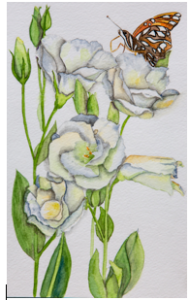 Lisianthus & Monarch Butterfly (Danaus plexippus)
Lisianthus & Monarch Butterfly (Danaus plexippus)
A book is a friend that knows the secret to waking up its reader’s imagination. An artist enhances the imagination by sharing experiences associated with visual imagery.
My friend Amber is a gifted artist, who created the artwork for my children’s book. I remember our first meeting at her studio. Amber enthusiastically took her place at her state-of-the-art workstation. Her artist’s palette was smudged with sample watercolors that allowed me to visually roll in a surreal field of wildflowers. Her art books felt right at home on a family heirloom bookshelf. I selected one of the books, inhaled deeply and said, “It still has that wonderful, musty, library smell.”
Amber reached for a seasoned charcoal pencil then focused her energy and talent on a sketchpad she took almost everywhere. She immediately started creating characters as I verbally described them. Within minutes, she had the lisianthus and monarch butterfly sketched, much to my amazement. She visited my gardens on many occasions and could visualize the flowers and butterfly, which frequented the gardens as well. We “clinked” our ice tea glasses as a sign of good things to come.
Now is the perfect opportunity for me to share the power and beauty of visual imagery as it applies to artists. Visual imagery allows us to see in the absence of visual stimuli. (Goldstein, Bruce E. 2011) I dared to think that visual imagery might be an art form in and of itself.
Some researchers suggest that visual imagery is the result of perception, and that artists benefit from bottom-up processing. If that were the case then electromagnetic energy (light) would focus an image from a visual stimulus onto Amber’s retina. That energy would then be converted into action potentials through the process of transduction and sent to her brain. (Lesson 3) The end result is perception, which is a function of the visual cortex. However, it has been suggested that the transduction associated with perception doesn’t apply to visual/mental imagery (recreation of the sensory world in absence of physical stimuli), and that imagery originates as a top-down process. (Goldstein, Bruce E. 2011) The cerebral cortex (grey matter) is defined as a higher brain area responsible for many cognitive functions such as perception, memory, thought, creativity, abstraction, and synthesis of movements. Because there is no visual input to be processed by the visual cortex, visual/mental images are the result of knowledge, expectations, and experiences, which reflect top-down processing. (Goldstein, Bruce E. 2011)
Researchers using a voxel-based morphometry scanning devices determined that artists have more grey matter in a part of their brains called the precuenus, which is located in the parietal lobe. This region might be linked to visual imagery and the ability to “manipulate visual images in the brain, combine them and deconstruct them.” (Hogenboom, Melissa 2014) Additional research suggests that artists have more grey and white matter in the cerebellum, which is responsible for the fine tuning of motor movements that make those movements more adaptive and accurate. (Knierim, James, Ph.D. n.yr.)
Other research builds a case for nature vs. nurture in that an artist may have a genetic predisposition for artistic talent, and that environmental upbringing and training are influential in terms of cultivating the talent. (Hogenbroom, Melissa 2014) Amber’s mother was a gifted artist as well.
I hope you experienced visual and mental imagery as a result of “visiting” Amber’s studio. Her visual imagery and apparent top-down processing assisted with the book’s character creation. Although I do not share the elements critical for the visual imagery that may define an artist, I appreciate the power of the brain areas that activate the visual and metal images.
Works Cited
Goldstein, Bruce E. “Glossary.” Cognitive Psychology Connecting Mind, Research, and Everyday Experience. 3rd Edition. Wadsworth Cengage Learning. Copyright 2011, 2008. pp. 270, 274.
Web Publications
Swenson, Rand, DC, MD, Ph.D. “Chapter 11: The Cerebral Cortex: General Organization.” Review of Clinical and Functional Neuroscience. Dartmouth Medical School. ©Swenson 2006. Web 28 July 2016.
https://www.dartmouth.edu/~rswenson/NeuroSci/chapter_11.html
Hogenboom, Melissa. Artists ‘have structurally different brains.’ BBC News. Science and Environment. © 2016 BBC. Web 28 July 2016.
http://www.bbc.com/news/science-environment-26925271
Knierim, James, Ph.D. “Cerebellum: Section 3, Chapter 5.” Neurosciences Online. ©1997-Present. The University of Texas Health Science Center.
http://neuroscience.uth.tmc.edu/s3/chapter05.html


